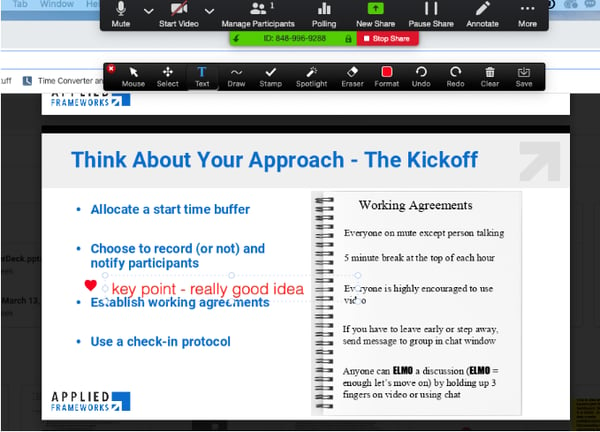While some techniques apply to both in-person and online meetings, there are quite a few new tools and techniques that facilitators and teams need to practice in order to stay engaged and productive when working remotely.
Proven methods for in-person and remote Scrum
Let’s start with some basics that are true for both online and in-person meetings.
- Publish your agenda in advance and consider framing the agenda as a series of questions to be answered during the meeting.
- For meetings that last longer than 90 minutes, build a scheduled break into the agenda so that people know when they can grab a coffee or check email.
- Leverage collaboration frameworks to help your attendees contribute and stay on topic. For example, ScrumMasters love retrospective frameworks like Speedboat to help people identify strengths and opportunities to improve. (For more about Speedboat, and other powerful retrospective frameworks, check out Keeping Retrospectives Fresh, a Scrum Alliance Collaboration at Scale Webinar and read Two Fast Retrospective Techniques, by Carlton Nettleton.)
New techniques for remote Scrum
Online meetings, especially for teams with members newly working from home, are much more successful if you follow a few additional recommendations.
- In addition to sharing the agenda with your participants ahead of time, let them know if your meeting will include video ahead of time so that everyone can be “video ready.”
- If the technology you are using to support your online meeting is new, add an agenda item to your meeting to review the technologies you will be using. Building in this upfront time for tool familiarization will increase productivity in the long run.

- Plan to start the meeting with a 5 minutes buffer to allow for technical challenges that inevitably slow down even the most comfortable remote worker.
- Let your participants know if you plan to record (or not) the meeting.
- Establish Working Agreements or revisit them to be sure that everyone is clear about what the teams’ expectations are about how to handle communication, questions, interruptions, breaks, etc. After a couple of meetings, you may want to revisit the issue to be sure you have the chance to address unanticipated situations or assumptions that impact your meetings.

- Don’t neglect the Opening and Closing portions of your meeting. Spending time to kick-off your meeting with a formal check-in can improve the productivity of all team members. Equally important is the check-out process. Too often the meeting close is rushed and key decisions and action items are not fully recorded.
- Incorporate tools that will allow you to use collaboration and decision-making frameworks that increase engagement and ensure all participants have their voices heard. Google Apps like Jamboard are great for online whiteboarding. Consider tools like Mural and Weave that come populated with a library of frameworks and templates. Your video conferencing platform might also have some useful built-in tools for increasing engagement. Zoom, the platform we use at Applied Frameworks, has polling, whiteboard and annotation features that help all participants stay engaged.
A helpful webinar for distributed teams
Our team recently put together a webinar on this topic, and we’re developing additional workshops in coming weeks.




